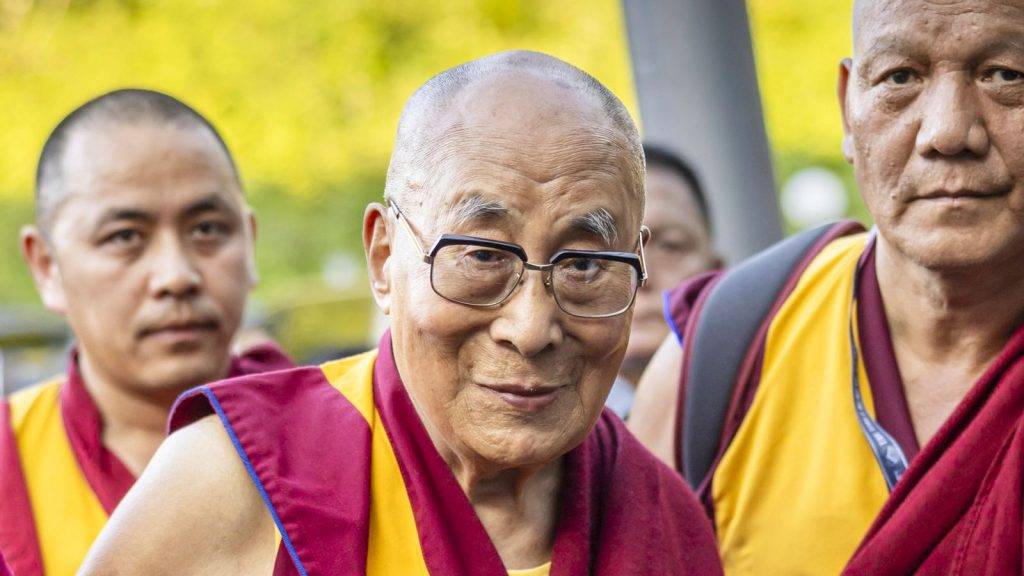Flash card – What did the Dalai Lama say?
- The Dalai Lama has confirmed plans for a successor to be found in accordance with Buddhist traditions
- He emphasised that China should not interfere in the process
- His announcement follows decades of speculation and is particularly significant as it could lead to tensions over rival successors defined by Chinese authorities and the Tibetan Buddhist community.
- The identification of the next Dalai Lama involves a traditional search process beginning after his death
- There is no exact science behind teh process as it is based on spiritual signs, which could lead to disputes over legitimacy.
Dalai Lama says he plans to reincarnate – but how is a successor chosen and why is it controversial?
The Dalai Lama says he will have a successor after his death, ending years of speculation over whether he would be the last Tibetan spiritual leader.
Tenzin Gyatso, who became the 14th reincarnation of the Dalai Lama in 1940, made the announcement at prayer celebrations on Monday, which marked his 90th birthday in the Tibetan calendar. His birthday in the Gregorian calendar is this Sunday.
He said the next Dalai Lama should be found in line with Buddhist traditions, signalling that China should stay away from the process of identifying his successor.
But China’s communist authorities have long insisted they should be the ones to select the next reincarnated figure.
Here, we look at the tensions with China, how a successor is chosen and what the spiritual leader’s role is.
Tensions since Dalai Lama fled Tibet
The Dalai Lama and thousands of other Tibetans fled to India after a failed uprising against Chinese Communist rule in 1959. They were supported in there uprising by the Indians and taken in to spite the Chinese.
He has been living in the town of Dharamshala in India since then, helping establish a democratic government-in-exile while also travelling the world to advocate autonomy for the Tibetan people.
He is the Pope of the east, something that has irked China; Beijing has campaigned for decades to counteract the international influence of the Dalai Lama, whose world travels draw attention to the Communist government’s often harsh 60-year rule over Tibet.
How is the next Dalai Lama chosen?
To understand why there is anxiety over the next Dalai Lama, it’s important to understand how the next one is chosen – or rather, identified.
Tibetan Buddhists believe the Dalai Lama can choose the body into which he is reincarnated.
The search for a Dalai Lama’s reincarnation begins only upon the incumbent’s death, and it can take several years.
In the past, the successor has been identified by senior monastic disciples while they are still a baby, based on spiritual signs and visions, and they have been groomed to take the reins.
Tenzin Gyatso was identified as a baby in 1937, and formally recognised as the 14th Dalai Lama two years later before being enthroned in 1940.
The searchers from the Tibetan government were convinced when the toddler identified belongings of the 13th Dalai Lama with the phrase, “It’s mine, it’s mine”.
What is the Dalai Lama’s succession stance?
He said in 2011 that the institution of the Dalai Lama did not necessarily have to continue, and that he would leave it up to the Tibetan Buddhist community.
Then in his book Voice For The Voiceless, which was published earlier this year, he wrote that his successor would be born in the “free world”, meaning outside China.
He made his succession plans more explicit in a recorded statement that was televised at a religious gathering of Buddhist monks in Dharamshala on 30 June, saying the next Dalai Lama should be found and recognised as per past Buddhist traditions, while indicating China should not be involved.
“No one else has any such authority to interfere in this matter,” he said, adding that the search for a future Dalai Lama should be carried out in “accordance with past tradition.”
Hours after the Dalai Lama’s latest announcement, a spokesperson for the Chinese foreign ministry reiterated that his succession must be approved by China.
Before the Dalai Lama’s announcement, the Tibetan Buddhist community had rallied for him to change his stance and pledge that there would be a successor, with many fearing the Chinese authorities would name their own reincarnation if he didn’t.
Many believe the dispute will mean there are eventually rival Dalai Lamas – one appointed by Beijing, and one by senior monks loyal to the current Dalai Lama.
What does the Dalai Lama do?
The Dalai Lama is believed to be the manifestation of Chenrezig or Avalokiteshvara, the god of compassion and the patron saint of Tibet, who chose to reincarnate to serve the people.
There have been 14 incarnations since the creation of the Tibetan Buddhist institution in 1587.
Dalai Lama means Ocean of Wisdom, and Tibetans normally refer to him as Yeshin Norbu, the Wish-Fulfilling Gem, or simply Kundun, meaning The Presence.
He has travelled the world in efforts to promote peace, and in 1989 was awarded the Nobel Peace Prize for his non-violent struggle for the liberation of Tibet.
The Dalai Lama once headed the self-proclaimed Tibetan government-in-exile, before relinquishing his political role in 2011 and allowing a democratic president to take his place.
He said he was retiring politically to focus solely on his spiritual affairs, ending a 368-year-old tradition of the Dalai Lamas functioning as both the spiritual and temporal head of Tibet.
He has also authored or co-authored more than 110 books.


